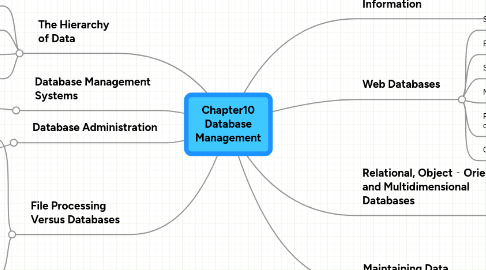Chapter10 Database Management
by wattana detbuntom


1. The Hierarchy of Data
1.1. character
1.2. field
1.3. record
1.4. data file
2. File Processing Versus Databases
2.1. File processing system
2.1.1. •Each department has its own set of files
2.1.2. •Used for many years
2.1.3. •Have data redundancy
2.1.4. •Isolate data
2.2. Database approach
2.2.1. •Programs and users share data
2.2.2. •Reduce data redundancy
2.2.3. •Improve data integrity
2.2.4. •Share data
2.2.5. •Allows easier access
2.2.6. •Reduces development time
2.2.7. •Can be more vulnerable
3. Database Management Systems
3.1. A DMBS provides a variety of techniques to restore the database to a usable form in case it is damaged or destroyed
4. Database Administration
4.1. Creates and maintains the data dictionary, manages security, monitors performance, and checks backup and recovery procedures
5. Databases, Data, and Information
5.1. Database
5.1.1. Collection of data organized in a manner that allows access, retrieval, and use of that data
5.2. Data
5.2.1. Collection of unprocessed items -Text,Numbers,Images,Audio,Video
5.3. Information
5.3.1. Processed data -Documents,Audio,Images,Video
